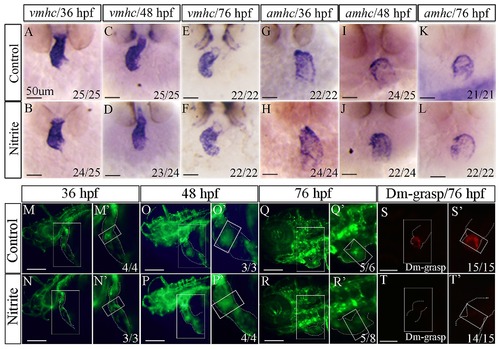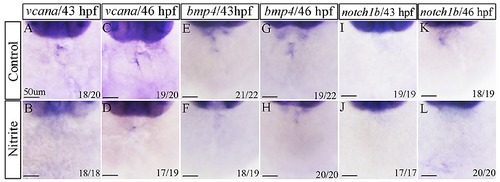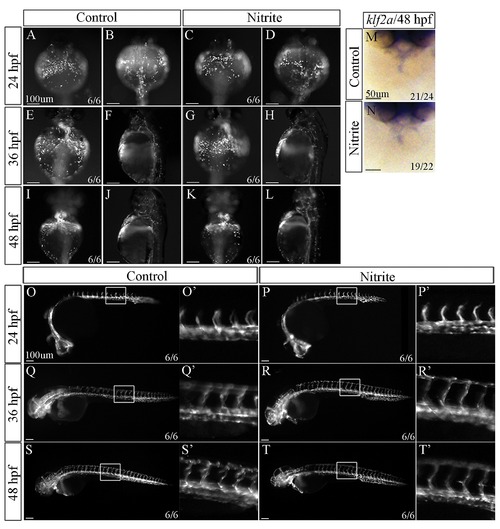- Title
-
Excessive nitrite affects zebrafish valvulogenesis through yielding too much NO signaling
- Authors
- Li, J., Jia, W., Zhao, Q.
- Source
- Full text @ PLoS One
|
Sodium nitrite caused defective development of zebrafish heart in a dose dependent way. (A?C) Zebrafish embryos exposed to 100 mg/l sodium... show more (A?C) Zebrafish embryos exposed to 100 mg/l sodium nitrite from 10 hpf exhibited cardiac edema from slight phenotype (B) to severe phenotype (C) compared to control embryos with normal heart (A) at 108 hpf. (D) A scatter plot showing the edema index (EI) of embryos exposed with different concentration of sodium nitrite. EI is defined as b/a. Average ± standard errors of EIs were shown in lines. (E?G) Histological sections showing 100 mg/l sodium nitrite exposure caused defective structure of zebrafish heart at 108 hpf. Compared to control embryos with normal pericardial membrane, myocardium and both superior and inferior valve leaflets (E), 4/7 embryos exposed to the nitrite showed thinner pericardial membrane and myocardium, and only superior valve leaflet but no formation of inferior valve leaflet (F), whereas 3/7 of the treated embryos displayed thinner pericardial membrane and myocardium and no formation of either superior or inferior leaflets (G). a: the semi-diameter of ventricle; b: the semi-diameter of the pericardial cavity. Red star (*): pericardial membrane; Black star (*): myocardium; Black arrow: position of superior valve leaflet; Black arrowhead: position of inferior valve leaflet; A: atria; V: ventricle. |
|
Histological and molecular analyses revealing excessive nitrite affected zebrafish heart valve development directly. Nitrite-exposed embryos were treated with 100 mg/l sodium nitrite from 10 hpf. (A?F) Histological sections showing defective valve development caused by nitrite exposure occurred from 48 hpf. At 36 hpf, the embryos exposed to nitrite exhibited similar histological heart structure (B) to that of control zebrafish, comprising one layer of myocardium and one layer of endocardium (A). At 48 hpf, endocardial cells of control embryos exhibited cuboidal shape in AVC between two chambers (C) but the exposed embryos did not have cuboidal endocardial cells in AVC (D). At 76 hpf, invagination of endocardial cells into cardiac jelly in AVC in control embryos formed superior primitive valve leaflet consisting of multilayer of cells (E); however, no superior primitive valve leaflet (no multilayer cells in the superior part of AVC) was formed in nitrite-exposed embryos (F). (G?N) Cardiac looping in zebrafish embryos shown by the expression of cmlc2 revealing abnormal cardiac looping caused by nitrite exposure occurred as early as 43 hpf. The expression pattern of cmlc2 was not affected by nitrite exposure at 36 hpf (G?H) and 40 hpf (I?J), but slightly abnormal (shown in white dotted curve) at 43 hpf (K?L) and obviously abnormal (shown in white dotted curve) at 48 hpf (M?N). (O?X) Nitrite exposures altered the expressions of molecular makers of valve progenitors at 48 hpf. nppa was not expressed in the AVC (rectangular box) of control embryos (O) but was ectopically expressed in the AVC of nitrite-exposed embryos (P). Compared to control embryos, nitrite exposure significantly decreased or abolished expressions of bmp4 (Q, R), vcana (S, T), notch1b (U, V) and has2 (W, X) in AVC. The number shown in the lower right-hand corner was the number of embryos exhibiting the typical phenotype shown in the panel to the number of embryos totally observed. Black arrow: position of cuboidal endocardial cells; Black arrowhead: position of superior primitive leaflet; White arrow: endocardium; White arrowhead: myocardium. |
|
Inhibiting NO signaling in nitrite-exposed embryos partially rescued defective development of cardiac valve in zebrafish embryos. (A) The cGMP level was dramatically increased in the nitrite-exposed embryos at 24, 36, 48 and 76 hpf, respectively. **: P<0.01. The values of cGMP amount in all the control embryos were normalized to 1.0, respectively. The value of cGMP amount in the nitrite-exposed embryos was the fold of the control embryos at the same developmental stage. (B) A scatter plot showing the increased EIs in the nitrite-exposed embryos were significantly reduced by microinjecting ODQ (sGC inhibitor) into nitrite-exposed embryos. Different treatments of embryos were shown in X-axis. EI (shown in Y-axis) of each embryos was shown in the plot. Average ± standard errors of EIs were shown in lines. (C?E) Defective histological structures of heart caused by excessive nitrite were partially rescued by microinjection of ODQ into nitrite-exposed embryos. Embryos were observed at 108 hpf. Compared to control embryos with normal pericardial membrane, myocardium and both superior and inferior valve leaflets (C), 6/8 embryos exposed to the nitrite showed thinner myocardium and defective formation of either superior or inferior leaflets (D). ODQ microinjection resulted in 3/6 of the embryos developed both superior and inferior leaflets (E). (F?T) Microinjection of ODQ partially rescued the diminished expressions of valve progenitor makers in zebrafish embryos at 48 hpf. nppa is not expressed in the AVC (rectangular box) of control embryos (F) but was ectopically expressed in the AVC of nitrite-exposed embryos (K). Microinjection of ODQ into nitrite-exposed embryos prevented 7 of 15 embryos from expressing nppa in AVC (P). Compared to control embryos, nitrite exposure significantly decreased or abolished expressions of bmp4 (G, L), vcana (H, M), notch1b (I, N) and has2 (J, O) in AVC. However, microinjection of ODQ into nitrite-exposed embryos resumed expressions of bmp4 (Q), vcana (R), notch1b (S) and has2 (T) in about half embryos. Red star (*): pericardial membrane; Black arrow: position of superior valve leaflet; Black arrowhead: position of inferior valve leaflet; A: atria; V: ventricle. |
|
Morphological changes of nitrite-exposed embryos at early development. Nitrite-exposed embryos were treated with 100 mg/l sodium nitrite from 10 hpf. They displayed a similar morphological phenotype to control embryos at 24 hpf (A, B). At 48 hpf, the nitrite-exposed embryos (D) looked very similar to control embryos (C) except that they showed a slightly shortened body length (D). When reaching 76 hpf, the nitrite-exposed embryos displayed normal diameter of eye, and heart development (E, G) when compared to control embryos (F, G). However, the body length of the exposed embryos was significantly shorter than control embryos (F, G). At 84 hpf, some of nitrite-exposed embryos started to exhibit cardiac edema (H, I). |
|
Excessive nitrite exposure affected endothelial cell accumulation and differentiation in the AVC at 76 hpf. Nitrite-exposed embryos were treated with 100 mg/l sodium nitrite from 10 hpf. Expression patterns of vmhc in ventricle and amhc in atria of nitrite-exposed embryos were similar to those in control embryos at 36 (A, B; G, H), 48 (C, D; I, J) and 76 hpf (E, F; K, L), respectively. Excessive nitrite exposure did not change the distribution of endothelial cell in the AVC of embryos at 36 hpf (M-N, M2-N2) and 48 hpf (O-P, O2-P2). Compared to control embryos at 76 hpf (Q-S; Q2-S2), 5/8 nitrite-treated embryos had fewer endothelial cells (R, R2) and 14/15 nitrite-exposed embryos lost the expression of Dm-grasp (T, T2), maker of endothelial cell differentiation in AVC, at the same stage. Panel M2-T2 were the magnification of the region outlined by rectangle in Panel M-T, respectively. Heart was outlined by dot-lined curves and the AVC in Panel M2-T2 was outlined by a small rectangle. |
|
Excessive nitrite exposure diminished expression of valve progenitor makers as early as 43 hpf. Expressions of vcana (A, C) and bmp4 (E, G) were observed in the AVC of control embryos at 43 hpf and 46 hpf. 100 mg/l nitrite exposure from 10 hpf significantly decreased their expressions in the AVC (B, D, F, H), respectively. Expression of notch1b was not seen at 43 hpf (I) but initiated at 46 hpf (K) in the AVC of control embryos. 100 mg/l nitrite exposure from 10 hpf abolished notch1b expression in the AVC of embryos at 46 hpf (L). |
|
Excessive nitrite exposure did not affect hemodynamics of zebrafish embryos. Embryos were exposed with 100 mg/l nitrite from 10 hpf. After nitrite exposure, embryos derived from Tg(gata1:DsRed) exhibited normal development of red blood cells at 24 (A?D), 36 (E?H) and 48 hpf (I?L), respectively. Consistently, klf2a did not change its expression pattern at 48 hpf after nitrite exposure (M?N). Similarly, embryos derived from Tg(flk1:GFP) displayed normal vessel development at 24 (O-P, O2-P2), 36 (Q-R, Q2-R2) and 48 hpf (S-T, S2-T2), respectively. Panels O2-T2 are the magnification of the region outlined by rectangle in Panel O-T, respectively, showing the normal development of vessels. |







